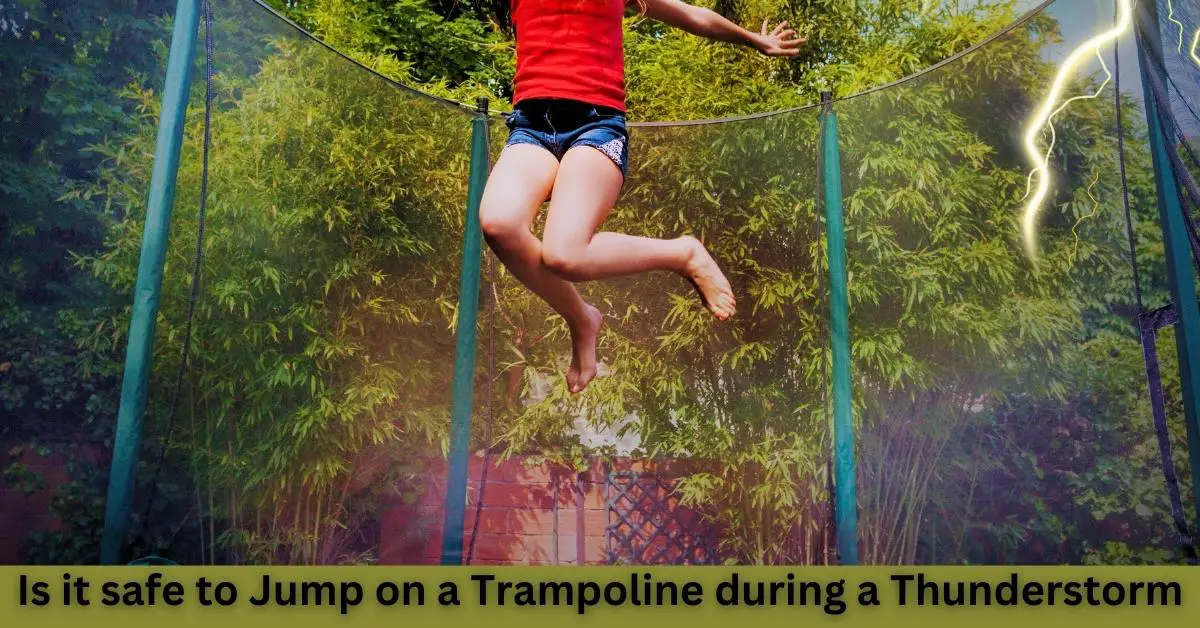I delve into the question of whether “Trampoline Safety During Thunderstorms”, my main focus is to understand the risks and precautions involved.
Lightning, a force of nature known for its deadly potential, becomes a central concern in this discussion. Its ability to strike from miles away and cause severe harm demands our attention and respect.
When it comes to trampolines, the situation becomes even more precarious during a thunderstorm. The metal frame and springs of a trampoline can serve as conductors for electricity, posing an increased risk to anyone using it.
As I explore this topic further, it becomes evident that caution and safety must take precedence to avoid potential injuries, property damage, or even tragic outcomes.
Through this article, I aim to provide insights into the risks associated with trampoline usage during thunderstorms and highlight the necessary precautions to ensure personal safety.
By understanding the potential dangers and adopting responsible decision-making, we can make informed choices and prioritize our well-being when thunderstorms loom overhead.
Is it safe to Jump on a Trampoline during a Thunderstorm: Jumping on a trampoline during a thunderstorm is not safe. The metal frame and springs can conduct electricity, increasing the risk of lightning strikes. Prioritize safety and avoid this activity.
Trampoline Safety During Thunderstorms?
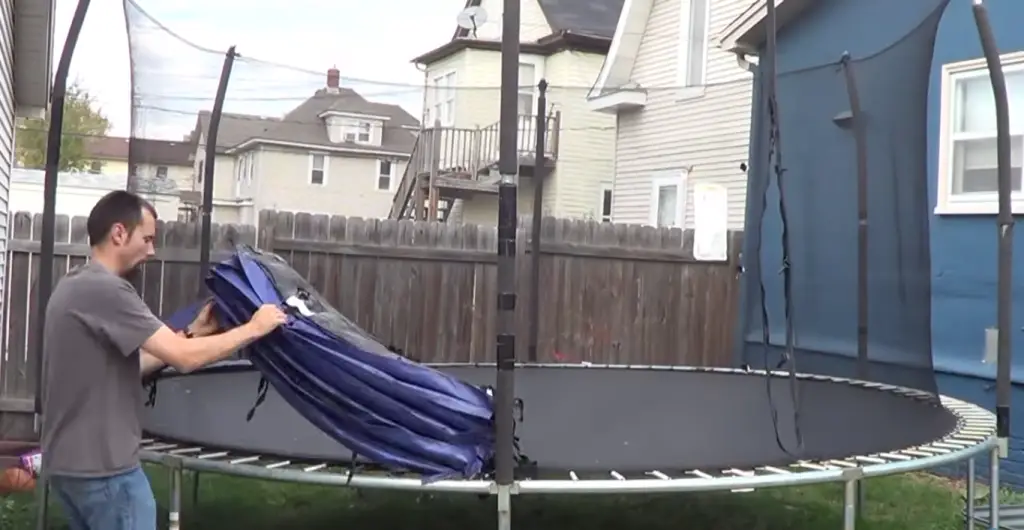
Jumping on a trampoline during a thunderstorm poses significant risks and potential dangers. Thunderstorms are known for producing lightning, a powerful and unpredictable natural phenomenon.
Lightning can strike from several miles away and carries a high risk of injury or even fatality. Trampolines, with their metal frames and springs, can act as conductors for electricity, increasing the likelihood of a lightning strike.
This puts trampoline users at a heightened risk of being struck by lightning, which can lead to severe injuries or even death.
When it comes to the question of using trampolines during thunderstorms, opinions may differ. Some individuals might underestimate the risks or believe that the chances of being struck by lightning are low.
However, it is crucial to prioritize safety and consider the potential consequences. Others may exercise caution and understand the inherent dangers, choosing to refrain from using trampolines during thunderstorms altogether.
Experts strongly advise against jumping on trampolines during thunderstorms. Safety organizations and weather authorities consistently emphasize the risks involved.
They recommend seeking shelter indoors as soon as a thunderstorm approaches and avoiding activities that expose individuals to the outdoors, including trampoline use.
These expert opinions are based on comprehensive research, historical data, and a commitment to promoting public safety.
Overall, due to the increased risk of lightning strikes, it is not safe to jump on a trampoline during a thunderstorm. Understanding the potential dangers and heeding expert recommendations is vital to ensure personal safety and avoid unnecessary risks during inclement weather.
Trampoline Wind Resistance: How Much Can It Withstand?
Trampolines aren’t built to handle strong winds very well. Even experts like Dr. Keith Alexander, who is involved in trampoline safety standards, agree with this. He explains that trampolines act like wings from an aerodynamic perspective.
So, if even a small amount of wind starts to tilt the trampoline, it can easily be blown away from your backyard. The safety net around the trampoline can make things worse by catching the wind and adding more force to move the trampoline.
The wind resistance of a trampoline depends on various factors. Typically, it’s said that a trampoline can be significantly shifted if it’s not properly anchored when the wind reaches around 40 miles per hour.
However, this can vary depending on factors like the layout of your yard, the trampoline’s position, how well it’s anchored, and the specific trampoline model.
If your trampoline is near a natural wind barrier like a wall or fence, it may take more wind to move it. Similarly, if it’s securely anchored down, it will be harder to shift.
Larger trampolines designed for Olympic-sized jumping will generally be more resistant to the wind compared to small trampolines for children.
In general, if the weather forecast predicts wind speeds above 40 miles per hour, it’s important to start thinking about how securely your trampoline is anchored to ensure it doesn’t get blown away.
How Should You Handle a Trampoline During High Winds?
When you know that strong winds are on the way, you have two choices for your trampoline:
- Completely disassemble the trampoline and store it away. This option can be time-consuming and inconvenient, especially if you frequently experience storms and hurricanes.
- Ensure that the trampoline is securely anchored down. This is a crucial step, especially if you don’t want to go through the hassle of taking it apart multiple times in a short period.
If you live in an area prone to storms and hurricanes, securing the trampoline becomes essential.
There are various ways to achieve this, and here are a few options to consider.
Using a Tree as an Anchor:
Dr. Alexander, the expert mentioned earlier, suggests a practical solution for securing a trampoline in strong winds. He advises using a sturdy tree as an anchor point.
By wrapping a rope around the tree and ratchet strapping the trampoline to it, you can keep it securely in place, even during powerful winds.
This method ensures that the trampoline won’t be blown away and provides a reliable way to protect it from wind-related damage. Just make sure to choose a tree that is strong and stable enough to withstand the force of the wind.
Utilizing Water Containers as Anchors:
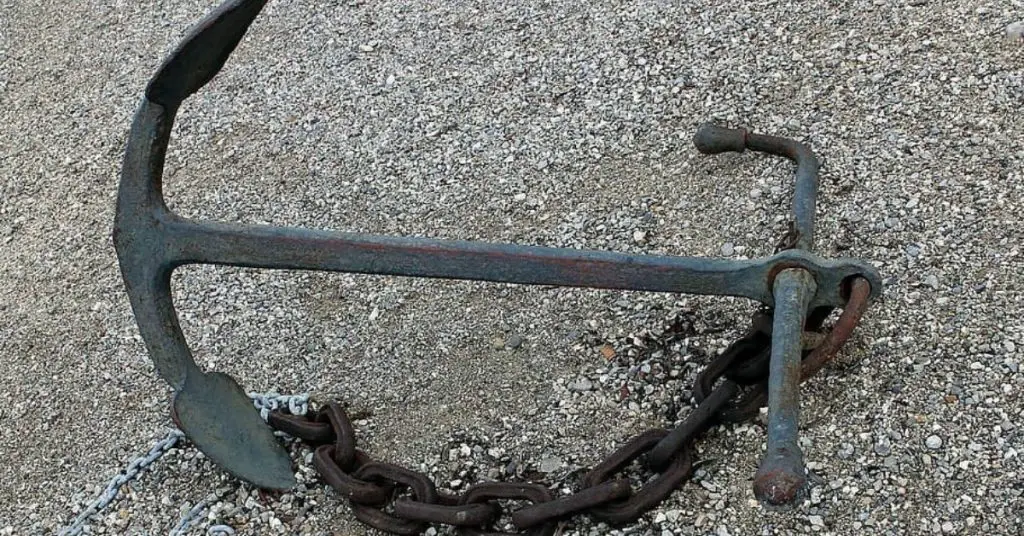
Another option to secure your trampoline is by using large water containers. These containers, typically around 20 liters or more in size, can be filled with water and tied to the trampoline frame.
By doing this, the weight of the water-filled containers will help prevent the trampoline from shifting or moving during most weather conditions.
This method provides stability and reduces the risk of the trampoline being blown away or displaced by strong winds.
It’s a practical and effective solution that doesn’t require much effort or additional materials.
Employing Sandbags as Anchors:

A common question that often arises is whether sandbags can effectively secure a trampoline.
The answer is yes, unless we’re dealing with extremely strong winds, sandbags are a highly effective method of keeping a trampoline in place.
To ensure maximum stability, it’s recommended to use as many sandbags as possible. Additionally, it’s important to make sure that the legs of the trampoline are securely attached to the frame.
If the legs are not properly attached, the sandbags may hold down the legs, but the trampoline mat itself could become detached and potentially separate from the frame.
Using sandbags as anchors is a practical and reliable way to keep your trampoline secure, reducing the risk of it being affected by moderate to strong winds.
Utilizing Concrete-Filled Tires as Anchors:
Another effective option I came across while researching this topic is to use old tires filled with concrete as anchors for the trampoline. Here’s how it works: Fill the tires with concrete and set bolts into the concrete while it is still wet.
Once the concrete has hardened, you can use rope or a ratchet strap to attach the trampoline to the bolts.
Before pouring the concrete, ensure that you have the tires positioned correctly in the desired locations. Once the concrete sets, it will provide a sturdy and reliable anchor point for the trampoline, helping to keep it securely in place, even during strong winds or inclement weather.
This method is an innovative way to repurpose old tires and create a solid foundation for your trampoline. Just remember to take the necessary precautions and follow proper guidelines when working with concrete for your safety and optimal results.
Utilizing Trampoline Anchors for Stability:
Some trampolines are equipped with their own set of anchors designed to secure them to the ground. However, if your trampoline doesn’t come with anchors, it’s highly recommended to purchase some separately.
There are two main types of trampoline anchors available:
- U-shaped anchors: These anchors are suitable for areas with light to moderate winds.
- Corkscrew Anchors: These anchors are specifically designed for areas with high winds. They have a spiral shape and can be screwed directly into the ground.
Both types of anchors offer significant additional protection for your trampoline. However, corkscrew anchors, due to their design, are less likely to be pulled out by extremely strong winds.
While browsing through customer reviews on Amazon, I came across feedback about the Eurmax USA trampoline stakes (although there are other brands available).
A couple of users mentioned that these anchors helped keep their trampolines secured even during winds exceeding 100 miles per hour.
Using trampoline anchors is a reliable and effective method to enhance stability and ensure that your trampoline remains securely in place, even in challenging weather conditions.
Consider Removing the Net:
This option complements the suggestions mentioned earlier. As stated earlier, the safety net on a trampoline can catch the wind and increase its momentum during high winds, making it more susceptible to movement.
If it is convenient for you to remove the safety net, I highly recommend doing so and ensuring that your trampoline is securely anchored.
However, it is important to note that using a trampoline without a safety net is not advisable, so remember to reinstall it before using it again.
By removing the net during periods of high winds, you can reduce the risk of the trampoline being affected by strong gusts. However, it is crucial to prioritize safety and always follow proper usage guidelines to prevent accidents or injuries.
Guidance from the American Academy of Pediatrics (AAP)
The American Academy of Pediatrics (AAP) strongly advises against jumping on trampolines during a thunderstorm due to safety concerns. According to their guidelines, children should immediately stop using trampolines when they hear thunder.
It is recommended to wait for at least 30 minutes after the last thunderclap before resuming trampoline activities.
The AAP’s recommendation aims to prioritize the safety of children while using trampolines, particularly during thunderstorms. Thunderstorms pose an increased risk of lightning strikes, which can be extremely dangerous.
By adhering to the AAP’s advice, parents and caregivers can help ensure the well-being and protection of children who enjoy trampoline activities.
Recommendations from the National Safety Council (NSC)

According to the National Safety Council, over 100 individuals lose their lives each year in the United States due to lightning strikes, and many of these incidents happen during outdoor recreational activities.
It is crucial to understand that lightning can strike even when the storm itself is several miles away. This means that even if the storm seems far off, the risk of lightning-related accidents and injuries still exists.
These facts emphasize the importance of being aware of the dangers posed by lightning and taking appropriate precautions, especially during outdoor activities.
By staying informed and following safety guidelines, individuals can help minimize the risk of being struck by lightning and ensure their well-being during thunderstorms.
Expert Advice from the National Lightning Safety Institute
The National Lightning Safety Institute also advises against using trampolines during a thunderstorm. This is because trampolines are made of metal, which conducts electricity and makes them susceptible to lightning strikes.
When lightning strikes a trampoline, the metal frame and springs can conduct the electricity, leading to the risk of electric shocks. If someone is jumping on the trampoline when lightning strikes, they can suffer severe injuries or even lose their life.
Additionally, if lightning strikes close to the trampoline, the force of the shockwave can cause a person to lose their balance and fall off the trampoline, potentially resulting in further harm.
It is crucial to prioritize safety and avoid using trampolines during thunderstorms to minimize the risk of lightning-related accidents and injuries.
Following the guidance provided by the National Lightning Safety Institute can help ensure the well-being of individuals using trampolines.
Ensuring Proper Grounding for the Trampoline
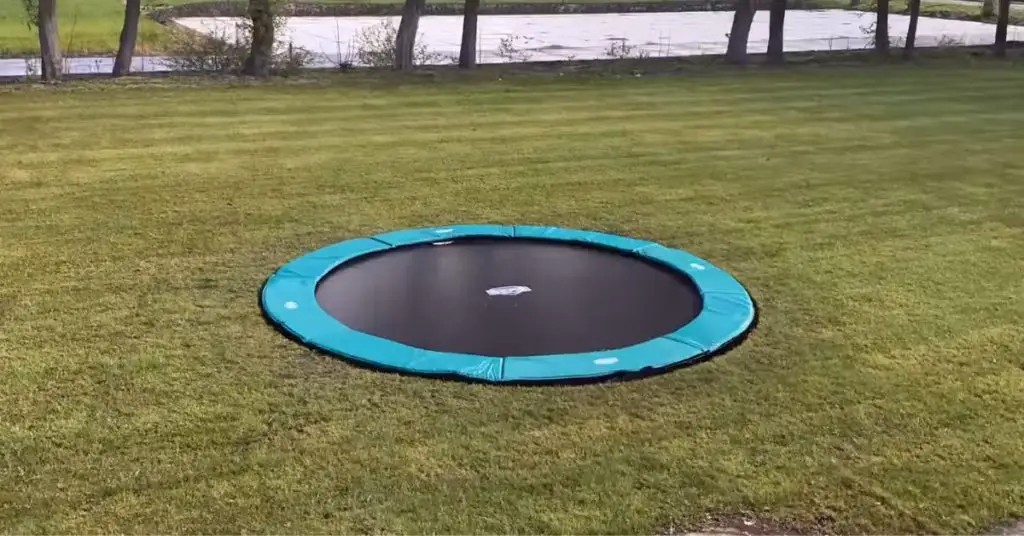
To minimize the risk of injuries while using a trampoline, there are several precautions you can take.
One important step is to make sure the trampoline is properly grounded. This helps reduce the chance of electrical shock if lightning strikes.
Additionally, regularly check the trampoline for any damage and make sure it is well-maintained. Damaged trampolines can increase the risk of injuries.
Following basic safety guidelines is also crucial. Use a safety net around the trampoline, allow only one person to jump at a time, and avoid attempting dangerous stunts.
It’s essential to supervise children when they are using the trampoline, and adults should refrain from jumping if they have consumed alcohol or drugs.
By taking these precautions and adhering to safety guidelines, you can help create a safer environment for trampoline use and reduce the risk of accidents and injuries.
The “30-30 Rule” for Lightning Safety
The “30-30 rule” is a helpful guideline to follow when deciding whether to continue outdoor activities during a thunderstorm. According to this rule, if you hear thunder within 30 seconds of seeing a lightning strike, it’s important to seek shelter right away.
Once you are indoors or in a safe place, you should wait for at least 30 minutes after the last sound of thunder before resuming any outdoor activities.
This rule is designed to keep you safe from the dangers of lightning. Thunder is a sign that lightning is nearby, and it’s crucial to take immediate action to protect yourself.
By following the 30-30 rule, you can reduce the risk of being struck by lightning, which can cause serious injuries or even be fatal.
Remember, it’s always better to err on the side of caution and prioritize your safety during thunderstorms. Pay attention to the timing between lightning and thunder, and make informed decisions about when it’s appropriate to continue outdoor activities.
Lightning and Trampolines
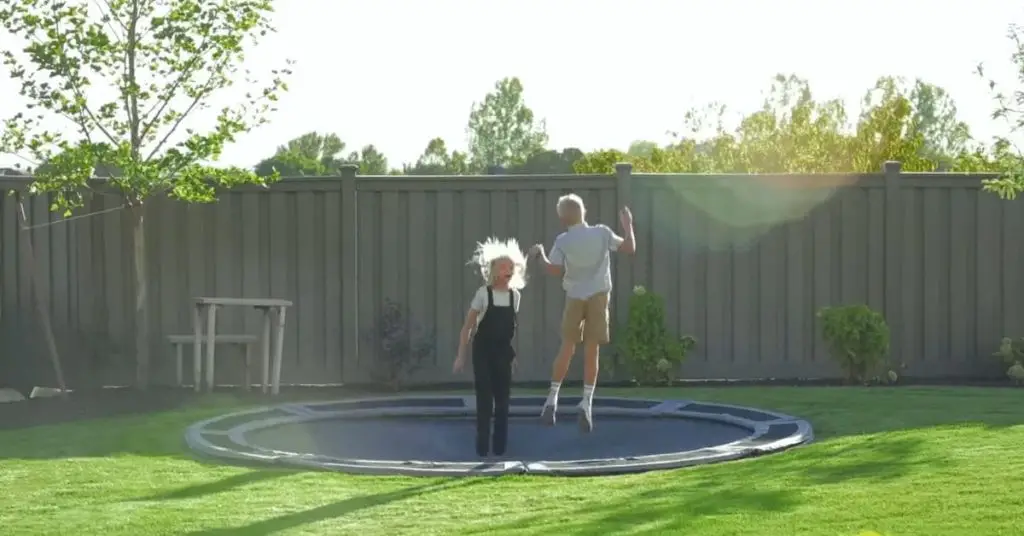
Thunderstorms bring with them the potential danger of lightning strikes. Trampolines, with their metal frames and conductive components, can attract and conduct electricity from lightning.
This poses a significant risk to trampoline users during thunderstorms.
Lightning is a powerful electrical discharge that can cause serious harm or even be fatal. When lightning strikes a trampoline, the metal frame and springs can conduct the electricity, posing a risk of electrical shock to those using the trampoline.
Even if the trampoline is not directly struck, nearby lightning strikes can still generate a shockwave that can cause individuals to lose balance and potentially fall off the trampoline, leading to injuries.
During a thunderstorm, it is crucial to understand the concept of a safe zone. This refers to a location or area where individuals can seek shelter to minimize their exposure to lightning.
When it comes to trampolines, the safest approach is to avoid using them altogether during thunderstorms.
Following guidelines from experts and organizations, such as the “30-30 rule” (waiting 30 minutes after the last thunderclap before resuming outdoor activities), can help ensure personal safety.
It is important to prioritize safety and make informed decisions when it comes to trampolines and thunderstorms. By understanding the risks associated with lightning and taking appropriate precautions, individuals can minimize the potential dangers and keep themselves safe during inclement weather conditions.
Safety Precautions
Safety Precautions When Using a Trampoline:
General Safety Guidelines for Thunderstorm Situations
- Seek Shelter: When a thunderstorm is approaching, it is crucial to seek shelter immediately. Stay indoors or find a sturdy, enclosed structure that can protect from lightning and other storm hazards.
- Monitor Weather Updates: Stay informed about weather conditions by listening to weather forecasts or using reliable weather apps. Pay attention to thunderstorm warnings or watches in your area.
- Stay Away from Metal Objects: Avoid contact with metal objects during a thunderstorm, as they can attract and conduct electricity. This includes avoiding trampolines, metal fences, poles, and other similar structures.
Specific Precautions for Trampoline Usage During Thunderstorms
- Do Not Use the Trampoline: It is strongly advised to refrain from using trampolines during thunderstorms. The metal frame and springs make trampolines susceptible to attracting lightning, increasing the risk of electrical shock.
- Securely Anchor the Trampoline: Ensure that the trampoline is properly anchored to the ground, following the manufacturer’s instructions. This can help prevent the trampoline from being blown away or displaced by strong winds during a thunderstorm.
Recommendations for Ensuring Personal Safety and Minimizing Risks
- Prioritize Safety: Always prioritize personal safety and the safety of others when it comes to trampoline usage. This includes following safety guidelines, being aware of weather conditions, and making informed decisions.
- Educate Yourself and Others: Familiarize yourself with safety recommendations from reputable sources, such as the National Safety Council and the National Lightning Safety Institute. Share this information with others to raise awareness about the risks and precautions associated with trampolines during thunderstorms.
- Be Prepared: Have an emergency plan in place in case of severe weather. Identify safe shelter areas and establish communication methods to stay connected with family members or caregivers during a thunderstorm.
By following these safety precautions, you can help ensure personal safety and minimize the risks associated with trampolines during thunderstorms. Remember, it is always better to err on the side of caution when it comes to severe weather conditions.
Alternative Indoor Activities
Alternative Indoor Activities During Thunderstorms:
Suggestions for Alternative Activities During Thunderstorms:
When thunderstorms roll in and outdoor activities become unsafe, here are some alternative indoor activities to keep yourself entertained:
- Board Games: Gather your family or friends and enjoy classic board games like Monopoly, Scrabble, or Clue. It’s a great way to have fun and bond with loved ones.
- Video Games: Dive into the world of video games and explore virtual adventures. Whether you prefer solo play or multiplayer games, there’s a wide range of options to choose from.
- Movie or TV Show Marathon: Settle in for a movie or TV show marathon. Pick a genre or series you’ve been meaning to watch and enjoy hours of entertainment.
- Arts and Crafts: Unleash your creativity with arts and crafts projects. Paint, draw, or try your hand at DIY crafts to make something unique and personal.
Indoor Games and Exercises to Consider:

Stay active and engaged with these indoor games and exercises:
- Indoor Sports: Set up a mini basketball hoop, play table tennis, or have a friendly indoor soccer match. Adapt these sports to fit your available space.
- Yoga or Workout Sessions: Follow along with online yoga classes or workout videos to stay active and maintain your fitness routine.
- Dance Party: Clear some space, turn up the music, and have a dance party. It’s a fun way to get moving and let loose.
- Brain Teasers and Puzzles: Challenge yourself with brain teasers, puzzles, or sudoku. They provide mental stimulation and can be enjoyed solo or with others.
Promoting Safety and Enjoyment During Inclement Weather
During thunderstorms, it’s essential to prioritize safety while enjoying indoor activities:
- Stay Informed: Keep track of weather updates and follow any warnings or advisories in your area.
- Unplug Electronics: To prevent damage from power surges, unplug electronic devices during storms or use surge protectors.
- Keep Emergency Supplies Handy: Have a flashlight, batteries, and a first aid kit readily available in case of power outages or emergencies.
- Follow Fire Safety Measures: Be cautious if using candles or cooking indoors during a power outage. Practice fire safety and ensure proper ventilation.
- Stay Connected: Use this time to connect with loved ones, engage in meaningful conversations, or enjoy quality time together.
Remember, safety should always be a priority during thunderstorms. Choose activities that can be enjoyed indoors and promote a safe and enjoyable environment for everyone involved.
FAQs:
Q:1 What are three activities to avoid during a thunderstorm?
Stay away from water, electronics, windows, doors, porches, and concrete during a thunderstorm. Avoid using corded phones to minimize the risk of lightning strikes.
Q:2 Is it safe to remain outdoors during a thunderstorm?
Remember, it is not safe to be outside during thunderstorms. If you find yourself outside, keep moving towards a safe shelter. Myth: Metal structures or items like jewelry do not attract lightning.
Q:3 What precautions should be taken with a trampoline during a storm?
A Trampoline Tie-Down Kit is used to secure your trampoline and prevent it from being blown over in strong winds. It uses straps and large metal stakes that screw into the ground. It’s not necessary to keep it on all the time, but it’s highly recommended during windy conditions.
Q:4 When is it safe to resume using the trampoline after a thunderstorm?
It is recommended to wait at least 30 minutes after the last thunderclap before using the trampoline again to ensure safety.
Q:5 How far away does lightning need to be to pose a risk while jumping on a trampoline?
Lightning can strike from several miles away, so even if the storm seems distant, it is still unsafe to jump on a trampoline.
Q:6 What are the risks of jumping on a trampoline during a thunderstorm?
Jumping on a trampoline during a thunderstorm increases the risk of being struck by lightning, which can cause severe injury or even death
Q:7 Why is it unsafe to jump on a trampoline during a thunderstorm?
Trampolines can conduct electricity due to their metal frame and springs, making them prone to lightning strikes.
Conclusion:
In conclusion, it is crucial to prioritize safety and avoid jumping on a trampoline during a thunderstorm. Trampolines, with their metal frames and conductive properties, increase the risk of being struck by lightning, which can have severe consequences.
The National Safety Council, the American Academy of Pediatrics, and the National Lightning Safety Institute all advise against trampoline use during thunderstorms.
While trampolines may be enjoyable and provide entertainment, the potential dangers posed by lightning make it essential to exercise caution. Lightning can strike from a considerable distance, and even if the storm appears to be far away, the risk remains.
To ensure safety during thunderstorms, it is recommended to follow general lightning safety guidelines, such as seeking shelter indoors and avoiding contact with water or electronic equipment.
Additionally, securing the trampoline properly, removing the safety net if possible, and waiting at least 30 minutes after the last thunderclap before resuming use are important precautions to minimize the risk.
By prioritizing safety and making informed decisions, we can prevent potential injuries and enjoy the trampoline safely when weather conditions are favorable. Remember, it is always better to prioritize personal safety over any recreational activity during a thunderstorm.
After reading this comprehensive guide, we hope you will be well aware of Trampoline Safety During Thunderstorms. If you have any questions, feel free to comment below!

